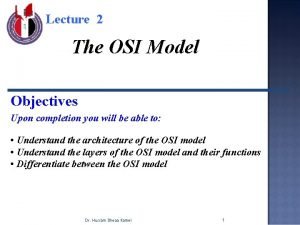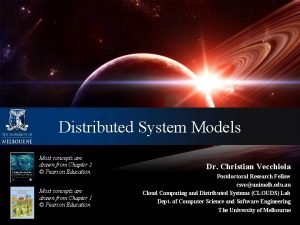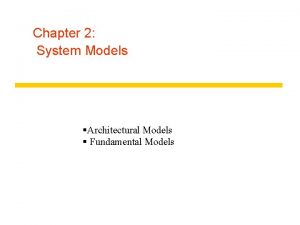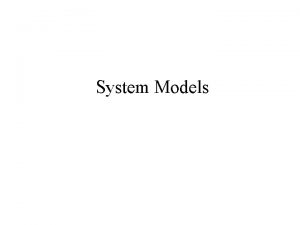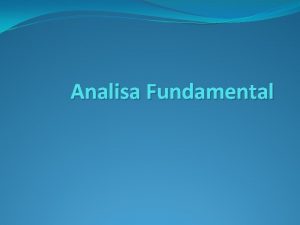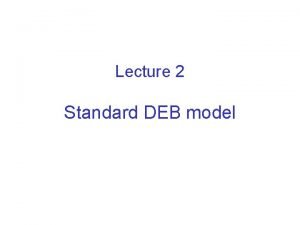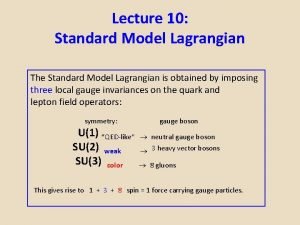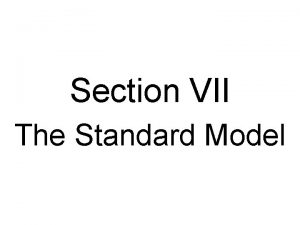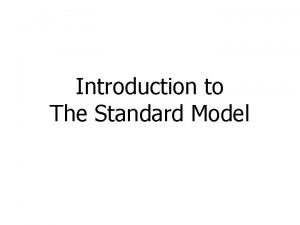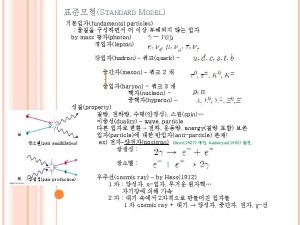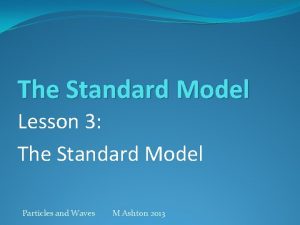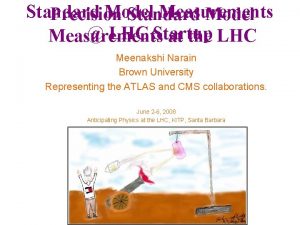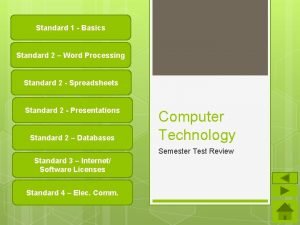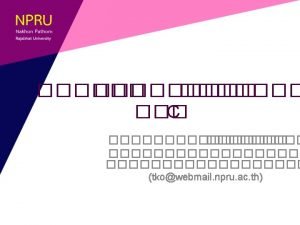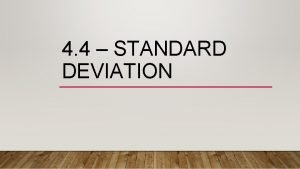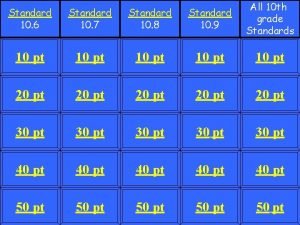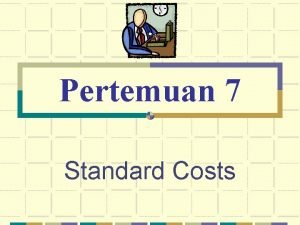Lecture 3 The Standard Model The fundamental model






















- Slides: 22

Lecture 3: The Standard Model The fundamental model for elementary particles. n n n Point Particles not strings ! No gravity ! What are the 3 families of particles? What’s a Boson, Fermion, Lepton and quark? Is Nature Supersymmetric? What are Higgs particles? ? Monopoles? ? ? Dr. H. Fearn CSUF Physics 1

http: //particleadventure. org/particleadventure/index. html http: //www 2. slac. stanford. edu/vvc/theory/hadrons. html Dr. H. Fearn CSUF Physics 2

Electrons & muons & Taus… oh my. Welcome to the particle ZOO. n n n The standard model is a good theory for the constituents of matter. Almost all the particles predicted have been found experimentally. It is fairly simple, and explains hundreds of particles and their complex interactions with only 6 quarks, 6 leptons and a few force carrying particles. (Double with SUSY. ) Dr. H. Fearn CSUF Physics 3

What are the 3 families of particles? Dr. H. Fearn CSUF Physics 4

Details ? ? Dr. H. Fearn CSUF Physics 5

Hadrons, Baryons & Mesons http: //www 2. slac. stanford. edu/vvc/theory/hadrons. html Dr. H. Fearn CSUF Physics 6

Bosons and Fermions n A Boson is a particle with integer spin. A photon has spin 1. So does a gluon and W, Z particles. Do not obey the Pauli exclusion principle, obey Bose-Einstein statistics. (eg. Vector bosons are often force carriers. Not Higgs boson though, Higgs Boson has spin =0) n A Fermion is a particle with odd ½ integer spin. An electron has spin ½. Also protons and neutrons… all matter particles in fact. Obey Pauli exclusion principle and Fermi. Dirac statistics. Dr. H. Fearn CSUF Physics 7

Leptons and Quarks n n n Leptons and quarks are supposedly indivisible particles. Leptons (Electrons, Muons, Taus, neutrinos & their antiparticles) are standalone particles and can be observed in the wild, err… “naked”. Quarks can only be found inside other particles, like Protons and Neutrons (in 3 s) and Mesons (in 2 s, quark +anti-quark). Dr. H. Fearn CSUF Physics 8

Quarks and Anti-Quarks Baryons and Mesons are colorless. Dr. H. Fearn CSUF Physics 9

What are Protons and Neutrons made of ? What is isotopic spin symmetry? n n n Quarks have both electric and color charge Color charges: Red, green & blue {1, 2, 3} And Flavors: { u d c s t b } yummy Dr. H. Fearn CSUF Physics 10

Quantum Chromodynamics QCD. Gluons have both color and anti-color, 9 varieties but 1 combination is white which is not allowed which leaves 8 types of gluon. Dr. H. Fearn CSUF Physics 11

A Physicists drawing of the same process; using an up quark. Dr. H. Fearn CSUF Physics 12

When gluons interact with each other… You get a GLUEBALL !! Dr. H. Fearn CSUF Physics 13

From QED to U(1) + SU(2) & SU(3) n n n Extension of the local U(1) symmetry of QED to include QCD SU(3), was done by Yang and Mills in 1954. Electroweak theory proven 1983. Larger symmetries involve non-commuting algebra (non-Abelian, ie. Ax. B is not Bx. A. ) Now called Yang-Mills theories. U(1) gauge symmetry refers to Local phase invariance. (A 1/2 wave plate in front of 1 slit, in a 2 slit interference experiment, is like AB-effect, introduce a B-field between the slits. ) n n U(3) refers to 3 colors, red green blue in QCD. Yang-Mills gauge symmetry U(2) involves isotopic spin which is the interchange of protons and neutrons in the nucleus. Dr. H. Fearn CSUF Physics 14

Higgs Boson adds particle mass n n These spin-less force particles give other particles their mass. The addition of the Higgs field (a field implies there associated force particles) n again helps to renormalize theory. . gets rid of infinities. Axions may represent yet another field, with much lighter particles. OK OK too many details… Dr. H. Fearn CSUF Physics 15

Renormalized electroweak theory: Weinberg-Salam-Glashow model confirmed, CERN 1983. Heavy W+ W- and Z particles found Dr. H. Fearn CSUF Physics 16

What about Super-symmetry? n n n In order to remove infinities in theory fermions should transform into bosons and vice versa. (This is a natural consequence of string theory!!) Each particle is predicted to have a superpartner called a sparticle. The partner for the electron (fermion) is the selectron (boson), for photon is photino etc. Each differs from its partner by spin ½. (More about this in the next lecture) Dr. H. Fearn CSUF Physics 17

Hunting for monopoles n n n Maxwell’s equations are more symmetric with monopoles. (write on board) GUT requires their existence Monopoles have not been found yet, because they are very massive and rare. Dr. H. Fearn CSUF Physics 18

Where do we stand with the TOE? Dr. H. Fearn CSUF Physics 19

Standard Model Draw-backs n A unified theory would consist of a mathematical framework in which all the forces and particles occur naturally. The masses and interaction strengths should be predicted by theory not input as experimental parameters. Gravity should be included, and it is NOT in the standard model. Dr. H. Fearn CSUF Physics 20

Reading Material: for the quiz… n n n n n Just kidding about the quiz! http: //particleadventure. org/particleadventure/index. html “Superheavy Magnetic Monopoles” Sci. Amer. April p. 106 (1982). “The search for proton decay” Sci. Amer. p. 54 June (1985). “Is Nature Supersymmetric” Sci. Amer. p. 52 June (1986) “The Higgs Boson” Scientific American p. 76 Nov (1986) “The theory formerly known as Strings” Sci. Amer. p. 64 June (1998). “Gauge theories of the forces between elementary particles”, by Gerard t’ Hooft Sci. Amer. , June (1980). Particle Physics: A Los Alamos Primer, Ed. by N. G. Cooper and G. B. West, Cambrige U. Press, 1988. Introduction to Elementary particles, by David Griffiths, Wiley 1987. THE 2 LAST BOOKS ARE EXCELLENT… QM and E&M by Griffiths are also excellent!! And I strongly recommend them to students. Dr. H. Fearn CSUF Physics 21

THE END See you Feb 23 rd Lecture 4: Strings and things Dr. H. Fearn CSUF Physics 22
 01:640:244 lecture notes - lecture 15: plat, idah, farad
01:640:244 lecture notes - lecture 15: plat, idah, farad The standard error of the mean
The standard error of the mean Difference between home language and standard language
Difference between home language and standard language Standard costing features
Standard costing features Standard pembelajaran
Standard pembelajaran Osi model lecture
Osi model lecture Distributed system models
Distributed system models Fundamental model in distributed system
Fundamental model in distributed system Architectural and fundamental models of distributed system
Architectural and fundamental models of distributed system Hình ảnh bộ gõ cơ thể búng tay
Hình ảnh bộ gõ cơ thể búng tay Frameset trong html5
Frameset trong html5 Bổ thể
Bổ thể Tỉ lệ cơ thể trẻ em
Tỉ lệ cơ thể trẻ em Chó sói
Chó sói Chụp tư thế worms-breton
Chụp tư thế worms-breton Chúa sống lại
Chúa sống lại Các môn thể thao bắt đầu bằng tiếng đua
Các môn thể thao bắt đầu bằng tiếng đua Thế nào là hệ số cao nhất
Thế nào là hệ số cao nhất Các châu lục và đại dương trên thế giới
Các châu lục và đại dương trên thế giới Công của trọng lực
Công của trọng lực Trời xanh đây là của chúng ta thể thơ
Trời xanh đây là của chúng ta thể thơ Mật thư anh em như thể tay chân
Mật thư anh em như thể tay chân Phép trừ bù
Phép trừ bù





